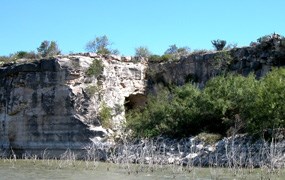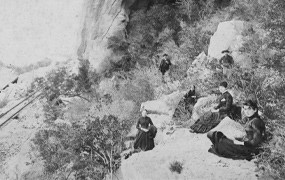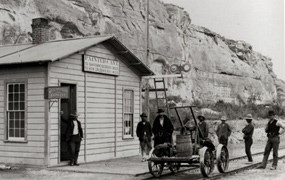
Construction of Railroad Tunnel No. 1 began in December of 1881 and was completed on July 21, 1882 becoming the first railroad tunnel built in Texas (San Antonio Weekly Express Vol. IX August 24, 1883). An entrepreneur named Mr. Meyers established a saloon and store above Tunnel No. 1 in the immediate vicinity of Captain Monroe's construction camp. The remains of Meyers store and saloon are designated as site 41VV586 Tunnel No. 1. 
Courtesy Whitehead Museum The Southern Pacific station between the Pecos River crossing and Flanders Station was called Painted Cave Station. The station began operation in 1883 and closed after the opening of the Pecos High Bridge. In 1892, Simon Shaw, Sr. was the section foreman at Painted Caves and Travis Brown, Sr. was the telegraph operator (La Hacienda 1976:117). Today, nothing remains of Painted Cave Station. What had survived into the 20th century was covered up by the waters of Amistad Reservoir. The nearby rock shelter with prehistoric Indian paintings that were the station's namesake is now known as Parida Cave. The site is operated by the Park Service as an interpretive site for visitors to Amistad National Recreation Area. 
Courtesy Barker Texas History Center of UT Austin The Shumla Station was used by the Southern Pacific from 1883 to 1893. In 1893, the Shumla cut-off, just east of the town, was completed to the new Pecos River High Bridge, eliminating the treacherous decent of the Rio Grande Valley to the crossing of the Pecos at its mouth. Flanders Station was located at a mile marker 433, as measured in miles from Houston. The old station was situated on the west side of Seminole Canyon roughly 1/4 mile north of U.S. Highway 90. The historic artifacts scattered in the vicinity of where Flanders Station once stood have been designated as site 41VV415. In the 1920's, Pat Sullivan leased land from Patty Moorehead Wilkins for ranching on the Rio Grande. The lease was along the Rio Grande from the mouth of the Pecos River to Seminole Canyon on the east and to the Pecos River High Bridge on the north. During the summers, when children were not in school in Comstock, the Sullivans (and frequently their neighbors, the Holcombs and Moores) would spend extended periods on the ranch. "The historic old depot was used for the kitchen and dining area and a separate building served as the sleeping quarters" (Kathleen Sullivan Grigsby 1976:155). |
Last updated: February 24, 2015
